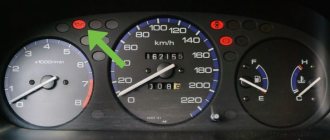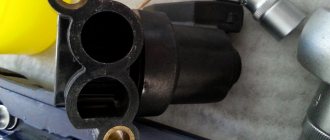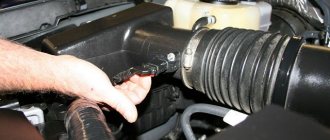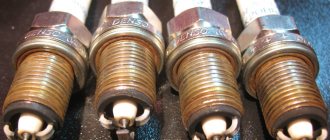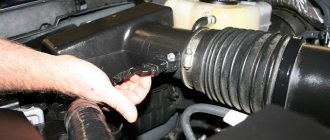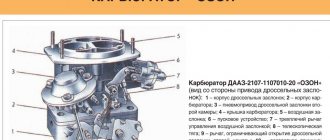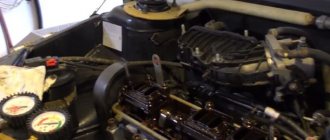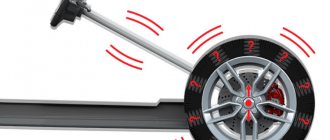Home » Engines » Rough engine idling - causes and malfunctions 428
Idling of a car engine is its operation without load and with the gas pedal fully released. Uneven idling is manifested in engine malfunctions, in which periodic sharp jumps in the number of revolutions are observed. Such an uneven ride indicates a malfunction of individual mechanisms, parts and components of the car.
Intake system leakage
Air must enter the engine only through the intake manifold. If the intake is damaged, air is sucked in from outside. Because of this, when starting the engine, the speed fluctuates, the engine does not hold speed at idle at all (stalls), and in some cases it is simply impossible to start. Air leaks in different places:
- through the walls of the collector (a common “disease” of plastic collectors in which microcracks form);
- through vacuum hoses;
- in the connection of pipes and hoses.
Intake manifold
If the collector is not damaged, but the “idles” begin to float, it is worth inspecting the gasket. Over time, it dries out and allows air to pass through. More “unaccounted” oxygen enters the cylinder - the mixture becomes lean, the internal combustion engine stalls. The situation is the same with the throttle valve gasket - the engine suffocates and does not hold speed at idle.
We carefully inspect the air pipes. Due to frequent and large temperature changes, rubber tubes dry out and crack. Why do engine speeds start to fluctuate? Air “unaccounted for” by the sensors again enters the combustion chamber, which leads to a situation similar to the previous one.
Air pipe
The engine may stall due to damaged vacuum hoses. Since they serve to transmit vacuum, the ingress of excess oxygen will instantly affect the operation of the car.
If your car has a gasoline vapor adsorber, inspect the valve. This is a common disease in domestic cars.
Canister valve
It is a faulty adsorber valve that causes the engine to go crazy. Replacing the valve helps eliminate the vibration problem at idle.
Causes and symptoms of malfunctions
Unstable engine idling is a reaction of the power unit to a problem that has arisen in one of the following vehicle systems:
- ignition circuit elements;
- electronics that control the injector;
- fuel supply;
- malfunction of the motor itself.
To figure out why the engine speed “floats”, it is recommended to use the method of elimination, moving from simple to complex. First you need to check your own suspicions - after all, only a car enthusiast knows what happened to the car shortly before the “shaking” of the engine appeared. Remember the latest repairs or replacement of parts in one of the listed systems and dig in this direction.
Advice. During the diagnostic process, pay attention to additional symptoms that appear at idle and engine operating speeds. These signs will help narrow down the circle of “suspected” elements and components of the car.
Ignition system problems
In this case, unstable operation of the engine at idle is accompanied by skipped ignition cycles in one or more cylinders - the engine begins to “triple”. The reasons lie in the malfunction of the following elements:
- spark plug;
- high voltage wires;
- high voltage coil (one common ignition module is installed on the injector);
- in carburetor engines - the main distributor (distributor).
A non-working spark plug or armored wire is detected by the old “old-fashioned” method - alternately removing the tips from the spark plug contacts while the engine is running. If, when the “cradle” is turned off, the speed of the power unit does not drop, you need to check the resistance of this wire and the condition of the electrodes. It is advisable to unscrew all the spark plugs in order to compare the color of the soot on the working part. A faulty spark plug will be indicated by black soot - remnants of unburned fuel.
Important point. Ignition system problems are characterized by stable “shaking” of the engine and shots into the intake manifold. If the engine speed “floats” (periodically increases and falls), the cause should be looked for elsewhere.
High-voltage wires can be easily checked for open circuits with a multimeter - the resistance should be in the range of 3.5–10 kOhm. The coils or ignition module are diagnosed in a service station. A separate story is the problem of the distributor installed on carburetor versions of the car. The following faults may cause unstable operation:
- a crack in the distributor cover where the wires are connected;
- the moving contact - the slider - has failed;
- The Hall sensor is heavily contaminated with metal shavings;
- mechanical ignition contacts are burnt;
- The bearing of the contact pair is worn out.
Electronics problems
Vibration and increased idle speed on a warm engine often occur due to the accumulation of errors in the controller’s memory. Cleaning is simple: disconnect the negative terminal of the battery for 15 minutes. Often this technique immediately gives a positive result - the power unit begins to operate in normal mode.
Recommendation. If cleaning must be carried out constantly, you should contact a service station. The reason for the accumulation of errors must be determined by a master electronics engineer.
The reason for the unstable speed of the power unit is often the operating algorithm of the electronic control unit. When one of the key sensors becomes unusable, the controller turns on emergency mode and prepares the air-fuel mixture, relying on working devices. Characteristic symptoms:
- The motor shakes and runs unstably.
- The injector supplies an enriched air-fuel mixture, which increases gasoline consumption.
- Black smoke comes out of the exhaust pipe.
- Soot is deposited on the spark plug electrodes.
In a modern car, more than one sensor is responsible for the engine idle speed. Information is transmitted to the controller by several main devices:
- Mass air flow sensor - intake air flow meter or its successor - absolute pressure sensor (MAP);
- lambda probe – measuring the amount of oxygen in the exhaust gases;
- DPDV – throttle position detector connected to the accelerator pedal;
- crankshaft position sensor (CPS).
The easiest way to check these devices is to disconnect the electrical connectors one by one, observing the behavior of the motor.
On which sensor, disconnecting the block will not bring changes, that element has failed. Be sure to clean the working surface of the DPKV - metal shavings are often magnetized to it, preventing the rotation of the toothed pulley from being properly recorded.
Fuel supply problems
Intermittent idle speed may be associated with the following problems with the fuel supply system:
- Damage to the idle air regulator built into the throttle valve block.
- Lack of fuel due to a drop in pressure in the fuel rail. The reasons are clogged coarse and fine filters, a malfunction of the bypass valve or electric fuel pump. In carburetor engines - the development of a mechanical pump drive.
- The canister purge valve is stuck in the open position.
- Worn or heavily soiled injector nozzles.
An important nuance. If the engine is unable to develop normal speed due to lack of fuel, the malfunction will appear in all modes, not just at idle. Low pressure in the fuel rail leads to a drop in power of the power unit and “dips” during movement.
A problem with the supply of gasoline or diesel fuel is detected by measuring the pressure in the fuel rail, where a special fitting is installed. If it is insufficient, the filters, relief valve and pump are checked. A stuck adsorber valve can be easily disassembled and replaced if necessary.
Dirty or worn injectors are unable to create a stable “torch” of fuel - they spray and leak when the engine is not running. Failure is diagnosed by checking the nozzles on a bench, so disassembly is indispensable.
Wear of engine parts
On cars with high mileage, unstable speed is an indicator of critical wear of the elements of the power unit. The symptom appears in the following cases:
- The back of the valve plate became covered with carbon deposits, causing the valve to stop closing. The cylinder fails because compression in it drops.
- A decrease in pressure in one or more cylinders as a result of uneven wear of the piston group.
- A stretched chain or belt has jumped 1 tooth on the pulley. The valve timing is disrupted, the engine loses power and vibrates in all modes.
- Problems in the crankcase ventilation system - the nozzle is clogged or there is gasoline in the oil, the vapors of which enter the cylinders for afterburning - the engine “suffocates”.
- Failure of the gasket under the cylinder head - antifreeze penetrates into the combustion chambers. A sure sign is white steam from the exhaust pipe and oil in the expansion tank.
Wear of valves and piston group is diagnosed by measuring compression . The non-working cylinder can be found using the method described above - remove the wires from the spark plugs at idle. To check the gas distribution mechanism, you need to remove the valve cover and align the marks on the crankshaft and camshaft pulleys with the marks on the stationary engine parts.
Idle speed control
The mechanism serves to maintain engine speed when the throttle valve is closed. The malfunction manifests itself in different ways: the car stalls, troits periodically, or constantly cannot go to idle.
Idle speed control
If you notice floating engine speeds, there are several reasons for the malfunction:
- Poor contact. The valve just doesn't seem to have any power. You need to inspect the wire terminals - often the terminals become oxidized and become covered with dirt.
- Dirt under the stem. If the regulator is disassembled, there is a chance to clean it - after reassembly, the problem goes away.
- Lack of lubrication in the rod. After lubrication, the valve operates normally.
When choosing a new regulator, it is advisable to avoid unknown manufacturers. Often such parts fail within a week, especially on Russian cars. If possible, try to purchase original parts.
Idle jet
If you have a carburetor with variable speed, inspect the jets. If dirt gets into them, the mixture becomes lean and the engine runs unstably.
Carburetor jet
Unscrew the solenoid valve and remove the XX jet. Using carburetor cleaner, wash off dirt, dry and reinstall. By the way, sometimes the reason lies not in the jet itself, but in the o-ring. After replacing it, the engine works properly.
Interruptions in the operation of the internal combustion engine and electrical equipment: signs, solutions
If the engine runs intermittently and there is a feeling that the engine is about to stall, you need to pay attention to the tachometer. If at the moment of unstable operation the arrow twitches, then the cause of the malfunction should be sought in the electrical equipment. These are symptoms of short-term failures in the ignition system (no spark). If there is no tachometer, you can determine problems with the spark without it. The car jerks sharply when driving.
But it is not always possible to quickly detect the causes of a short-term loss of spark. Often, as noted above, these are bad contacts or the ignition coil. Another culprit is the capacitor and dirty contacts. If new contacts are installed and the motor runs unevenly, this means they are bad.
Crankcase ventilation valve
The mechanism removes gases from the crankcase into the combustion chamber through the intake manifold. Why does the speed fluctuate due to dirty ventilation? If the valve is clogged or does not open well, the pressure inside the system increases. Crankcase gases enter the combustion chamber in excess quantities. The malfunction can be noticed by traces of oil that is squeezed out of all seals and gaskets. If the engine speed begins to fluctuate, by cleaning or replacing this valve, the problem disappears.
Crankcase ventilation valve
It is important to know! The operation of the internal combustion engine is affected not only by the valve itself, but also by the condition of the ventilation system pipes.
They should be elastic and free of cracks. If the tube bends like plasticine and does not return to its original shape, we urgently replace it. This means that there is a critical layer of soot inside it.
Dirty crankcase ventilation pipe
The ventilation system is the “lungs” of the engine. By eliminating blockages, engine operation is stabilized in all aspects - speed is leveled, consumption is reduced, and the car picks up speed more easily.
Gaps during acceleration
When accelerating a car, the load on the engine increases, which requires more fuel-air mixture, so most problems that cause failure during acceleration are associated with a lack of fuel or air. Check the condition of the fuel pump, filters, rail pressure, spark quality (in a gasoline engine). Changing the settings - mixture quality and ignition timing - is controlled by the electronics, so it is better to start diagnosing the problem by checking the dynamic indicators with a scanner directly during the trip.
Remember: if your car is equipped with an electronic “E-gas” pedal, there are usually three reasons that cause “failure” when you press it: shorted contacts, failure of the clutch and brake position sensor, or a system error.
When you press the gas pedal hard, used cars often experience a delay in the opening of the intake manifold flaps. This is a purely mechanical problem when, due to age and vigorous use, the collector becomes overgrown from the inside with a thick layer of soot “spitted out” by the cylinders of oil (and soot from the USR). The swirl flaps in the intake manifold can be cleaned or removed, just like the USR valve, but this must be done physically and programmatically, in a certified service center.
Air flow sensor
It is located between the throttle valve and the air filter. The sensor determines the volume of air passed through and sends information to the ECU. The latter adjusts fuel injection based on its data.
Mass air flow sensor
Inside the mass flow sensor there is a temperature compensation resistor, which often fails. Because of this, the sensor incorrectly determines the volume of oxygen, and accordingly, the control unit makes incorrect corrections. In some cases, you can get by with cleaning the sensor, but often it has to be replaced entirely.
Owners often fell for low-quality sensors. An original mass air flow sensor can cost 10 thousand rubles or more.
Therefore, there is a temptation to buy a cheaper analogue. But after installing it, the problem does not go away (or it goes away, but not for long). And only with a new original sensor the unit receives the correct information.
Popular brands:
Mercedes-Benz GL-Class
Vehicle characteristics
In 2001, the line of the VAZ automobile concern was replenished with the five-door hatchback VAZ 2114. The platform for creating the model was the VAZ 2109. Basically, the car was equipped with 4 cylinder 8 valve engines. The power system consists of an injection mechanism and an electronic control unit.
Engine operation is controlled by special sensors that inform the central module about engine performance. The module processes information and sends an impulse to the devices that need to be activated at the moment:
- prepares the required mixture quality depending on the speed and engine speed;
- distributes the spark among the cylinders in a certain sequence.
During production, the model was equipped with different engines.
| Parameter | Meaning | ||||
| Engine | 2111 | 11183 | 21124 | 21126 | 21114 |
| Configuration | L4 | L4 | L4 | L4 | L4 |
| Volume, l | 1499 cm3 | 1596 cm3 | 1599 cm3 | 1597 cm3 | 1596 cm3 |
| Number of valves per cylinder | 2 | 2 | 4 | 4 | 2 |
| Piston stroke | 71 mm | 75.6 mm | 75.6 mm | 75.6 mm | 75.6 mm |
| Cylinder diameter | 82 mm | 82 mm | 82 mm | 82 mm | 82 mm |
| Compression ratio | 11,5 | 9.6 — 10,0 | 10.3 | 11 | 9,6 |
| Gas distribution mechanism | OHC | OHV | OHV | OHV | OHV |
| Rated power | 77 l. With. at 5400 rpm min. | 82 l. With. at 5300 rpm min. | 89 l. With. at 5 thousand rpm min. | 98 l. With. at 5600 rpm min. | 81.6 l. With. at 5200 rpm min. |
| Max. torque | 116 Nm, at 3 thousand rpm. min. | 125 Nm, at 3 thousand rpm. min. | 131 Nm, at 3700 rpm. min. | 145 Nm at 4 thousand rpm. min. | 125 Nm, at 3000 rpm. min. |
| Supply system | injector | injector | injector | injector | injector |
| Maximum speed, km | 160 | 167 | 172 | 182/175(automatic transmission) | 175 |
| Acceleration time from 0 to 100 km/h, s | 15 | 13,2 | 12,4 | 11,2/13,1 | 12,5 |
| Fuel | AI 93 | AI 95 | AI 95 | AI 95 | AI 95 |
| Claimed gas mileage | 7.6 l/100 km combined cycle | 7.8 l/100 km combined cycle | 7.0 l/100 km combined cycle | 7.2 l/100 km combined cycle | 7.2 l/100 km combined cycle |
Throttle valve
The idle operation of an injection engine also depends on the throttle valve. Over time, it becomes covered with soot, which is why it does not close completely. This usually happens after 100–150 thousand kilometers. More oxygen enters the combustion chamber, causing the idle speed to fluctuate. The problem can be solved by dismantling and thoroughly cleaning the mechanism.
Dirty throttle valve
Why should this work be trusted to specialists? Often, after cleaning it yourself, the problem does not go away - the motor vibrates, and even the “Check” lights up. The fact is that on modern cars you need to adapt the damper after cleaning. An adapter with CAN support is used for this.
Injector malfunction
With mileage, the injectors become dirty, causing them to spray fuel incorrectly. This is immediately noticeable in the behavior of the car - consumption increases, power drops, the car starts poorly and does not idle.
Cleaning injectors
Often owners try to solve the problem the easy way by pouring some additive into the tank. But no matter how expensive the additive is, it will not give the same effect as ultrasonic cleaning on a stand. Yes, to do this you need to remove all the injectors. But the result exceeds all expectations - the corrections return to normal, the speed is equalized, and the consumption decreases.
Spark plug
The quality of ignition of the mixture directly depends on their condition. If at least one of the spark plugs is faulty, it will be immediately noticeable by terrible vibration and unstable speed. There may be several reasons:
- the life of the spark plug has been exceeded (for conventional ones it is 20-30 thousand kilometers, for iridium ones – 100);
- the gap between the electrode is increased;
- the electrode is covered with carbon deposits, which prevents a spark from breaking through.
Spark plug with oil deposits
If the spark plugs are covered in oil soot, you need to “dig” towards the valve seals and piston rings. The former require replacement after 150–200 thousand kilometers. But with rings the situation is individual. It happens that they become coked after only 100 thousand, but with timely maintenance there should be no problems with the rings for at least 250 thousand kilometers. Oil also leaks due to a clogged crankcase ventilation system, which we talked about earlier. If the spark plug is filled with gasoline, check the injectors and sensors.
How to understand why failure occurs when you press the accelerator
Often, the source of the problem is indicated by additional signs of a malfunction - for example, a “reluctant” engine start “on cold”, a general decrease in power (even before failures appear), increased fuel consumption. A very important criterion is when the problem manifests itself. If you notice that the engine spins up nonlinearly, as if there is a counterforce preventing it from gaining speed, most likely the reason is a clogged fuel or air filter. If the car “jerks” during acceleration with a smooth opening of the throttle, and, when pressed more intensely, it suddenly “shoots” - the jerks are associated with a lack of fuel. Dips during over-throttle and prolonged pressing and holding of the gas pedal, multiplied by difficult starting of a cold engine, indicate a malfunction of one or more spark plugs (and their coils).
Flooded or faulty spark plugs can also cause the gas pedal to fail.
The spark plugs that come with the car from the factory are more durable than most commercially available consumables, so it is recommended to do the second and subsequent replacements at shorter intervals.
Sometimes the problems of loss of throttle response, jerking, stepwise acceleration during acceleration are not at all related to the operation of the engine. On cars with automatic transmission, this is how severe wear appears. You will notice it when switching during acceleration - first a second delay without reaction to the gas pedal, then a push and acceleration. In cars with gas equipment, such a reaction to gas begins to occur when the gas reducer or its sensor breaks down. At the same time, the car begins to consume two to three times more gas. In diesel engines, an adequate response to vigorous pressing of the gas pedal is greatly impaired by refueling with low-quality fuel with a high sulfur content, or with a type of diesel fuel that does not correspond to the season.
Reduced fuel pressure
Let's look towards filters. There are two of them - coarse and fine cleaning. The first is located in front of the pump, the second is behind it.
Filters need to be changed every 30 thousand kilometers.
It is important to check the vacuum regulator valve in the fuel rail. It causes problems when driven over 200 thousand kilometers. There is a more serious problem - the pump is faulty. It may turn on, but not produce the required pressure. By measuring the outlet pressure, conclusions can be drawn. Note that the pump often burns out when driving on an empty tank, as it is cooled by the fuel itself. To avoid having to replace the pump in the future, keep the fuel level at least 1/4.
Instability of speed in intermediate modes
A problem typical for diesel cars. The reason is rust on the injection pump plunger. This happens due to water getting into the tank (possibly due to simple condensation).
Rusty injection pump plunger pairs
The consequences are high fuel consumption, exhaust smoke and increased wear of the fuel injection pump. To prevent this, many people install separators in the fuel system. This “sump” retains not only water, but also various impurities that may be in the tank.
Low compression in cylinders
If the compression test shows a disappointing result, the engine will need to be repaired. Compression drops for various reasons:
- Burnout of the cylinder head gasket. In this case, the oil breaks into the expansion tank, the antifreeze level drops, and there is “mayonnaise” on the dipstick. The gasket burns out due to improper assembly of the cylinder head after repair, due to overheating or impaired fuel combustion in the cylinder.
- Faulty hydraulic compensators or incorrect valve adjustment. This can be determined by a characteristic metallic knock. You can’t drive like that - you can quickly “sentence” the camshaft.
- "Standing" of piston rings. At the same time, the grooves of the piston rings become coked. This happens with infrequent maintenance, using low-quality oil and during short trips without load.
- Cylinder scuffing. This happens on old engines with a mileage of 250-300 thousand kilometers. Seizures can occur ahead of time due to overheating, using bad oil, or driving with low oil levels. On engines with a clogged USR, all deposits enter the combustion chamber, where they act as an abrasive, lifting up the hone.
The reasons for floating idle speed can be different and appear only in certain modes. But in any case, this should not be considered the norm. The sooner the problem is identified, the easier and cheaper it is to make repairs. Keep an eye on the condition of your car, and it will reciprocate!
Working intermittently is not tripping
Do not confuse interruptions in engine operation with tripping, when one of the cylinders does not function. When the motor “trokes” there will be no twitching. In this case, bad traction occurs. But at idle speed there will still be twitching.
If the engine of a VAZ-2107 car runs intermittently, then the problem is definitely with the ignition system. If, when you sharply press the gas, the engine stalls, and then picks up and starts to pick up speed, then the reason is in the carburetor. The ignition system has nothing to do with it. Rarely, dips may be due to a faulty coil. The latter produces a weak spark.

